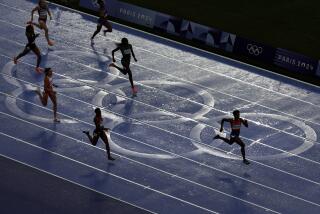Gamesmanship has its place at the Olympic Games
The physical part of judo was easy for Travis Stevens to comprehend.
The shoving and grappling. The spectacular throws. The chokeholds.
Even as a kid, Stevens could see the speed and strength required. But it took several years of competing at a high level before he recognized the subtler aspects of the sport.
The laundering. The tailoring. The extra starch.
Most top judo players have a technique for making their uniforms — called gis — as stiff and close-fitting as allowable under the rules. The harder they are to grab, the better the chances of winning.
“Sleeve length is very important,” Stevens said. “I’ve got it down to a science.”
In the hyper-competitive world of Olympic sports, even the tiniest details can make a difference. Just ask the swimmers who shave their bodies to glide more cleanly through the water.
As the 2012 London Olympics draw closer, it’s all about gaining a competitive edge.
“There is a whole history of pushing the envelope,” said Mark Dyreson, a Penn State professor who has studied the Games extensively. “We’re talking about athletes willing to do all kinds of crazy things.”
They are trying to go a little more citius, altius, fortius than the next guy, without doping or otherwise cheating. It’s a story as old as the Olympics themselves.
In ancient Greece, athletes knew their city-states would award them money and tax breaks for winning, so they developed special training regimens and ingested homeopathic substances to boost their performance, Dyreson said.
Such extremes were frowned upon in the early years of the modern Games. The British, in particular, promoted a more temperate approach.
The Academy Award-winning film “Chariots of Fire” featured British officials criticizing one of their own sprinters for employing a professional coach.
“They had this strange notion that you’re not supposed to train seriously,” Dyreson said. “They accused the Americans and others of perverting amateurism.”
Today, athletes around the world know that such restraint has long since fallen by the wayside.
“If you don’t go to the edge of the rules,” Olympic shooter Eric Uptagrafft said, “everyone else has a bit of an advantage.”
That explains why shooters wear stiff jackets to help them keep steady and pass lighters over their gun barrels — soot-blackened sights cut down on glare.
In the prone rifle competition, Uptagrafft used his engineering background to design an attachment that fine-tunes the barrel’s vibrations.
“You’re trying to get that last 5% of accuracy,” he said. “One point could win it.”
Clothing and equipment aren’t the only things that are tweaked. Athletes are constantly refining technique.
On some serves, badminton players try to flick their rackets right up to waist level, the maximum height limit. Sailors wanting to gain speed in light winds might be tempted to subtly rock their boats or work the boom, an illegal maneuver called “pumping the sails.”
“We have a jury out on the water,” U.S. Olympic veteran Zach Railey said. “They’re pretty good at watching.”
In kayaking, certain racers take advantage of anomalies in the slalom course. If a particular gate is swinging a few inches higher above the water, a competitor can partially sink his or her boat and go under — as opposed to around — the swinging pole.
“Some guys, their whole plan start to finish is to be as close to the poles as possible,” U.S. team member Scott Parsons said. “It can be faster.”
But if officials spot an infraction, they will levy a time penalty at the end of the run.
“It’s hard to say that taking a shorter line is always going to win,” Parsons said. “It doesn’t always work out.”
Gamesmanship can also come into play. Tennis players who fall behind in a match have been known to request bathroom breaks in hopes of changing the momentum.
In judo, the advantage that athletes often talk about is sartorial. Gi alterations became so commonplace that the International Judo Federation began using a special measuring device to uphold minimum standards.
Officials want to be sure that sleeves reach within five centimeters of the wrist and include at least 10 to 15 centimeters of room around the arm.
Stevens, who competes in the 81-kilogram division, said one of his teammates spreads baby oil on her forearms to be sure the device will slide inside her tailored sleeves.
He hang-dries his gi to make the fabric stiff, then pushes right up to the brink of the rules by shortening his sleeves and adding extra fabric to the back.
“So when it’s being measured, the sleeves just pass,” he said. “But when I drop my arms, they pull up tight and they’re shorter.”
His opponents at the London Games might complain; it’s part of the game for judo players to grumble about each others gis.
“It’s something we all go through,” he said. “We figure out ways to bend the rules but not break them.”
When it comes to the Olympics, every inch counts.
twitter/LATimesWharton
More to Read
Go beyond the scoreboard
Get the latest on L.A.'s teams in the daily Sports Report newsletter.
You may occasionally receive promotional content from the Los Angeles Times.











